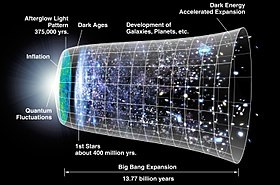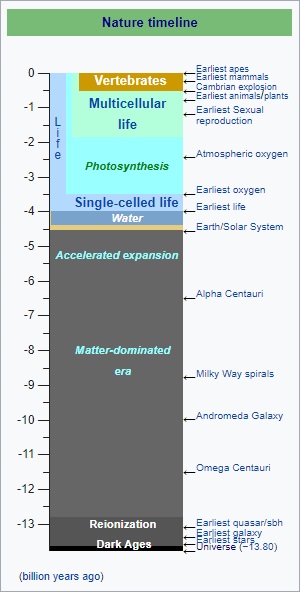|
|
| |
|
|
| |
|
|
|
|
| |
 |
| Diagram of evolution
of the (observable part) of the universe from
the Big Bang (left), the CMB-reference
afterglow, to the present. |
Creation Theories
The chronology of the universe describes the history and
future of the universe according to Big Bang cosmology.
The earliest stages of the universe's existence are
estimated as taking place 13.8 billion years ago, with
an uncertainty of around 21 million years at the 68%
confidence level.
Chronology in five stages
For the purposes of this summary, it is convenient to
divide the chronology of the universe since it
originated, into five parts. It is generally considered
meaningless or unclear whether time existed before this
chronology.
The very early universe
The first picosecond (10−12) of cosmic time. It includes
the Planck epoch, during which currently understood laws
of physics may not apply; the emergence in stages of the
four known fundamental interactions or forces—first
gravitation, and later the electromagnetic, weak and
strong interactions; and the expansion of space itself
and supercooling of the still immensely hot universe due
to cosmic inflation.
Tiny ripples in the universe at this stage are believed
to be the basis of large-scale structures that formed
much later. Different stages of the very early universe
are understood to different extents. The earlier parts
are beyond the grasp of practical experiments in
particle physics but can be explored through other
means.
The early universe
Lasting around 370,000 years. Initially, various kinds
of subatomic particles are formed in stages. These
particles include almost equal amounts of matter and
antimatter, so most of it quickly annihilates, leaving a
small excess of matter in the universe.
At about one second, neutrinos decouple; these neutrinos
form the cosmic neutrino background (CνB). If primordial
black holes exist, they are also formed at about one
second of cosmic time. Composite subatomic particles
emerge—including protons and neutrons—and from about 2
minutes, conditions are suitable for nucleosynthesis:
around 25% of the protons and all the neutrons fuse into
heavier elements, initially deuterium which itself
quickly fuses into mainly helium-4.
By 20 minutes, the universe is no longer hot enough for
nuclear fusion, but far too hot for neutral atoms to
exist or photons to travel far. It is therefore an
opaque plasma. At around 47,000 years, as the universe
cools, its behaviour begins to be dominated by matter
rather than radiation. At about 100,000 years, helium
hydride is the first molecule. (Much later, hydrogen and
helium hydride react to form molecular hydrogen, the
fuel needed for the first stars.)
At about 370,000 years, the universe finally becomes
cool enough for neutral atoms to form ("recombination"),
and as a result it also became transparent for the first
time. The newly formed atoms—mainly hydrogen and helium
with traces of lithium—quickly reach their lowest energy
state (ground state) by releasing photons ("photon
decoupling"), and these photons can still be detected
today as the cosmic microwave background (CMB). This is
currently the oldest observation we have of the
universe. |
|
 |
| A theoretical
timeline of the universe. |
The Dark Ages and
large-scale structure emergence
From 370,000 years until about 1 billion years. After
recombination and decoupling, the universe was
transparent but the clouds of hydrogen only collapsed
very slowly to form stars and galaxies, so there were no
new sources of light. The only photons (electromagnetic
radiation, or "light") in the universe were those
released during decoupling (visible today as the cosmic
microwave background) and 21 cm radio emissions
occasionally emitted by hydrogen atoms. The decoupled
photons would have filled the universe with a brilliant
pale orange glow at first, gradually redshifting to
non-visible wavelengths after about 3 million years,
leaving it without visible light. This period is known
as the cosmic Dark Ages.
Between about 10 and 17 million years the universe's
average temperature was suitable for liquid water
273–373 K (0–100 °C) and there has been speculation
whether rocky planets or indeed life could have arisen
briefly, since statistically a tiny part of the universe
could have had different conditions from the rest as a
result of a very unlikely statistical fluctuation, and
gained warmth from the universe as a whole.
At some point around 200 to 500 million years, the
earliest generations of stars and galaxies form (exact
timings are still being researched), and early large
structures gradually emerge, drawn to the foam-like dark
matter filaments which have already begun to draw
together throughout the universe. The earliest
generations of stars have not yet been observed
astronomically. They may have been huge (100-300 solar
masses) and non-metallic, with very short lifetimes
compared to most stars we see today, so they commonly
finish burning their hydrogen fuel and explode as highly
energetic pair-instability supernovae after mere
millions of years. Other theories suggest that they may
have included small stars, some perhaps still burning
today. In either case, these early generations of
supernovae created most of the everyday elements we see
around us today, and seeded the universe with them.
Galaxy clusters and superclusters emerge over time. At
some point, high energy photons from the earliest stars,
dwarf galaxies and perhaps quasars leads to a period of
reionization that commences gradually between about
250-500 million years, is complete by about 700-900
million years, and diminishes by about 1 billion years
(exact timings still being researched). The universe
gradually transitioned into the universe we see around
us today, and the Dark Ages only fully came to an end at
about 1 billion years. |
|
The universe as it appears
today
From 1 billion years, and for about 12.8 billion years,
the universe has looked much as it does today. It will
continue to appear very similar for many billions of
years into the future. The thin disk of our galaxy began
to form at about 5 billion years (8.8 Gya), and the
Solar System formed at about 9.2 billion years (4.6 Gya),
with the earliest traces of life on Earth emerging by
about 10.3 billion years (3.5 Gya).
From about 9.8 billion years of cosmic time, the slowing
expansion of space gradually begins to accelerate under
the influence of dark energy, which may be a scalar
field throughout our universe. The present-day universe
is understood quite well, but beyond about 100 billion
years of cosmic time (about 86 billion years in the
future), uncertainties in current knowledge mean that we
are less sure which path our universe will take. |
|
The far future and ultimate
fate
At some time the Stelliferous Era will end as stars are
no longer being born, and the expansion of the universe
will mean that the observable universe becomes limited
to local galaxies. There are various scenarios for the
far future and ultimate fate of the universe. More exact
knowledge of our current universe will allow these to be
better understood. |
|
 Wikipedia: Chronology of the universe Wikipedia: Chronology of the universe |
|
|
|
|
|
|
|
|
|
|
|
|
|
|
|
|
Search Fun Easy English |
|
|
|
|
|
|
|
|
|
|
|
|
|
|
|
About
Contact
Copyright
Resources
Site Map |